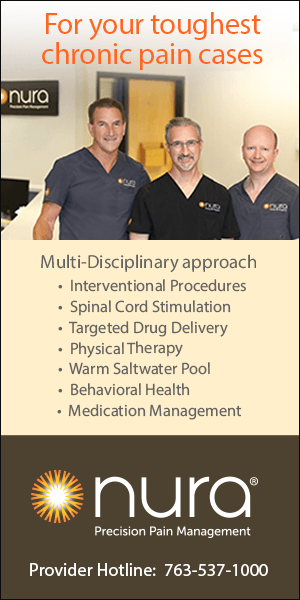hen a patient has a fever, they go to urgent care. They are seen relatively quickly, and the problem is addressed. However, when that same patient has a mental health need, they are sometimes forced to wait weeks or even months for an appointment. This delay is not acceptable, especially when annual estimates suggest 60 percent of people who have a mental health issue don’t receive help. There are many reasons why people don’t pursue support for their mental health care.
Behavioral Health
Removing barriers
A new way to access mental health care
BY MARC VAN HERR, CEO
Some people struggle to find a therapist they like or don’t know where to look. There can also be stigma or shame around admitting you need help or for reaching out for it. Consider US Olympic gold medal gymnast Simone Biles. When she announced that she was taking a step back from competition during the Olympic games in Tokyo due to her mental health, fans went ballistic. They called her weak and said she was letting her team and her country down. It’s no wonder people don’t reach out for mental health care help when they need it.
And what happened to Biles comes after a year of social isolation, where mental health has been brought to the forefront of more people. Yet, despite that, there is still a stigma surrounding mental health care. Since the start of the covid-19 pandemic, approximately four in 10 adults in the United States have reported symptoms of depressive disorder. This is up from one in 10 adults in 2019. A poll also found that more adults have reported negative impacts on their mental health and well-being, including difficulty sleeping or eating, increased alcohol or substance abuse, and increased stress and anxiety. Still, many people won’t schedule an appointment with a mental health professional even if they could benefit from it.
Many people think they can or should be able to cope independently and don’t want to be perceived as needing mental health care. Or they believe therapy is for people with more significant problems than theirs. Sometimes a person may not be aware they need help or that seeing a professional would help. Regardless of why someone may not get mental health care, it’s vital they can see a professional quickly when a person decides to reach out for an appointment. Unfortunately, the system is not designed to meet these needs.
How we are currently addressing mental health is not working.
Why do we need Urgent Care for Mental Health?
Mental health is one of the only types of health care that is almost exclusively reactive. If the medical community treated our physical health the same way mental health is treated, they wouldn’t be doing mammograms, prostate exams, or physicals. Instead, they would just wait until you developed cancer and then begin care. This is obviously a ridiculous notion. Yet, it’s how we treat mental health.
Desmond Tutu said, “There comes a point where we need to stop just pulling people out of the river. We need to go upstream and find out why they’re falling in.” In 2019, more than 47,500 people died by suicide. That’s one death every 11 minutes. Suicide is the tenth leading cause of death in the United States. But it’s not just suicide. Just like a physical injury, when mental health issues are left untreated, they can worsen and be more challenging to treat and lead to more severe health problems. If someone ignores their mental health, it can add stress to their body. This can come out in various ways, such as chronic pain or high risk of stroke, heart attack, and obesity.
And untreated mental illness can snowball. For example, someone who has untreated severe depression may find it challenging to do daily tasks, including getting dressed and working. Not being able to work or losing a job can add a financial strain and stress over housing, food, and how to pay for mental health care if one chooses to seek help. It’s estimated that a quarter of homeless adults have a serious mental illness. How we are currently addressing mental health is not working.
A new way to address mental health care
Now, more than ever, we need to find a new way to address mental health care. When mental health is ignored or it’s too hard to see a therapist, suicide rates increase. During the coronavirus pandemic, suicide hotlines saw an increase in calls. In addition, more Americans admitted to feeling a strain on their mental health. One of the best forms of suicide prevention is to provide access to care people need when they need it. Not weeks or months later.
One of the main ways suicide is addressed now is through suicide hotlines. These hotlines are great and help prevent suicides when a person calls in. However, the flaw in using suicide hotlines as a solution is they require us to wait to offer help until someone is literally on the cusp of ending their life. And it’s putting all the burden on the person who is experiencing one of the very darkest moments of their lives to reach out for help. We need to do better. We can do better.
Connecting people to mental health professionals
How the medical system cares for mental health needs to change. There needs to be more of a proactive approach where mental health is treated more like physical health. When it comes to physical health, it’s proven that working out regularly, eating a balanced diet, and seeing a massage therapist or chiropractor will help your body be in good, workable shape.
There are some easy steps for achieving proactive care for mental health. For example, when people see a therapist regularly, it can give them the skills to recognize signs of an onset of depression or other conditions and the tools to deal with it proactively, much like working out boosts your physical muscles.
When the medical community thinks of mental health as it thinks about physical health, it can be better integrated into our total care solutions. Research shows that more people live longer, healthier lives when we are proactive instead of reactive with physical health. The same is true with mental health.
Designing a new model
With these things in mind, we developed Urgent Care for Mental Health (UCMH). It addresses the wait time for mental health appointments, offering same or next day counseling appointments and quick access, typically a week or less, to children’s psychiatric services. Launched in 2018, the program makes it easy for patients to connect with quality providers in the state of Minnesota.
There is nothing like UCMH anywhere else in the country. Think of it as the Uber of mental health care. Uber itself doesn’t give rides to people. Uber is the platform that connects people who need rides with people who offer rides. The same is being done with UCMH. The program doesn’t provide care–it connects people who need mental health care with providers.
Untreated mental illness can snowball.
We have seen firsthand how better access to mental health care can positively impact the community. Recently, a woman called the 24/7 appointment request phone line. She was experiencing deep depression and hopelessness. Three hours later, she was in a therapist’s office where they made sure she was safe, provided her with tools to help manage her mental health, and created a plan moving forward.
Another woman contacted psychiatric service providers for weeks, searching for an appointment for her teen daughter who was suffering from depression and anxiety. The soonest appointment she could find was three months out. We were able to assist her in scheduling an appointment for her daughter with a psychiatric service provider in just two days.
How Urgent Care for Mental Health works
Our mission is to help anyone who is looking for mental health care in the state of Minnesota. The program has providers who can see patients aged three and up in both local and virtual settings.
Many people don’t know where to start when it comes to their mental health. And they are unaware of when they should see a professional. When someone finally gets past the stigma of needing to see someone for their mental health, they usually end up searching for a therapist online to schedule an appointment. Then they have to wait for the appointment. The average wait time is 25 days when appointments are scheduled this way. Though we are often able to have appointments available within the same or next day, one of our biggest hurdles is educating people on when to use our services and keeping the services top of mind.
Our affiliate providers are passionate and do great work. Many are independent or in smaller groups with the capacity for new patients. They have the freedom to accept any or no insurance, set their hourly rates, appointment schedule, how to treat patients and run their practice as they see fit. We require that they respond to any new client opportunity within four business hours, and, if appropriate, offer an appointment either later that same day or the next business day. Our providers are subject to a thorough vetting process, including license verification, complaint history, personal referrals and ensuring the provider is a good fit for our program.
Access to our services is available through channels ranging from social media targeted ads to search engine optimization and other technology-driven tools. In addition, we have a strong network of referral partners who interact with populations that can utilize our services at a higher rate than the general public. These include county social workers, homeless shelters, women’s shelters, medical clinics, hospitals, teachers, and other community-based nonprofits.
Physical and mental health care are tied together. When you address mental health needs, physical health can also improve. And vice versa. This is why it is important for physicians to be aware of what we do and how our services work. We offer an effective new access point for patients who need counseling services in a timely fashion.
When it becomes standard practice for the whole patient to be treated, many mental community-wide health issues will decrease.
This new model of care can be scaled up to a state, regional, or even national level. It can also work in nearly any sized market, which is incredibly important for increasing access to mental health in rural communities. For the next three years, our goal is to expand the number of locations across the state to provide access to anyone in need.
Our current capacity is 200 new patients each month between all of our locations. While this is a good starting point, there is ample room for growth. The target is 100-plus locations by the end of 2025. The goals also contain a heavy emphasis on technology so that UCMH and the provider can maintain contact with the client to help ensure their long-term mental health stability. Ultimately, we hope to provide everyone in the state access to same or next day mental health care, whether they live in the North Woods or North Minneapolis. Everyone should have mental health care access.
Marc Van Herr, is CEO of Urgent Care For Mental Health.
MORE STORIES IN THIS ISSUE
















